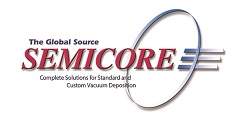The entire surface of substrates is sometimes applied with thin film coatings in the form of a continuous unbroken film. However, most of the times, the final form of whatever specific material is being applied is patterned. Thus only certain specific areas are coated, while others remain uncoated.
Thin Film Deposition Processes
There are two principal approaches to achieve this effect, namely Subtractive, or the Etch Back process; and Additive, or the Lift Off process. Subtractive, or the Etch Back process involves the coating of the entire surface, followed by the removal of select portions to form the desired pattern.
Some sort of physical masking agent is normally used in the pattern generating step, followed by the removal of portions without damaging anything else by means of an appropriate type of etching system.
In the Additive, or Lift Off process, the pattern generating step involving some form of physical masking agent is followed by the coating process resembling the use of a stencil. The openings in the mask allow only the desired pattern to get applied onto the actual substrate. The excess that ends up on the mask top is removed when the mask is lifted off. This article discusses this Lift Off Thin Film Deposition process.
Pattern specification is a major concern in the selection of a PVD process for Lift Off. A physical mask can be used if the pattern dimensions and tolerances are comparatively large. The mask needs to be photoresist for smaller dimensions, tighter tolerances and sharper line resolution.
Moreover, to obtain good results in micron or smaller dimensions, the deposition vapor stam needs to have a long mean free path and impinge on the masked substrate at right angles to its surface. The former needs low chamber pressure, normally below 10-4 torr, while the latter typically needs a relatively long throw, which marks the distance between the source and the substrate.
For the aforementioned reasons, the PVD process of choice is usually Thermal Evaporation. The source is typically placed on the center of the bottom of a vertical cylindrical chamber, while the substrate holder is a dome that rotates at a vertical axis centered over the source at 18 inches or more. The substrate holder is typically curved, i.e., a part of a sphere with some radius of curvature. The throw distance and the radius of curvature must be equal for Lift Off.
The vapor particles travel in parallel to all points on the dome. Each particle is on a direct radial line and will hit the dome surface at right angles to the plane that would be tangent to the surface at that particular point. This condition generates a perpendicular incidence on the curved dome surface that is required for optimum pattern accuracy.
However, substrates are most probably flat in contrast to this ideal curved surface, resulting in a deviation from completely perpendicular incidence. A good rule of thumb for better accuracy Lift Off patterns is to maintain this angular error to below 5°.
For substrates like semiconductor wafers in standard tooling domes, the vapor stream is at right angles to the wafer center and increases toward the edges. Here, the optimum error being relied on the wafer diameter with respect to the throw distance. Larger wafers need longer throw distances to obtain high resolution Lift Off results. Moreover, longer distances need a longer mean free path, which represents better vacuum pressure.
Another key fact related to Lift Off tooling is that while the throw distance remains constant across the entire dome, there will be drop in the intrinsic vapor deposition rate from its optimum at the center of the dome directly over the source to lower values nearing the perimeter.
According to Knudsen's Law, this must follow a hypothetical cosine curve for the increasing deviation of evaporant stream angle from zero (vertical) at the center to its upper limit at the perimeter of the dome.
This intrinsic non-uniformity of the deposition thickness must be offset by a fixed blocking mask inbetween the dome and the source working in conjunction with dome rotation to successfully block a part of the heavier central deposition to decrease it to the same level as the deposition at the perimeter.
Details in the designed shape of the mask play a vital role to obtain optimum thickness uniformity. This uniformity mask is a large scale fixed blocking mask behind which the dome rotates and is somewhat different from the fine scale patterning mask (photoresist) which rotates with the dome/substrates.
Conclusion
Lift Off PVD thin film deposition process is a very useful technique, particularly when selective etch back is complicated or impossible because of the unavailability of suitable selective etchants for the specific materials being used.
About Semicore Equipment
Semicore is a manufacturer and worldwide supplier for the electronics, optical, solar energy, medical, automotive, military and related high technology industries.
Our high-performance production or R&D vacuum sputtering and thin film evaporation systems provide coatings on a variety of materials including plastic films, glass, ceramics, metals and hybrid substrates.
Whether you want to take advantage of our proven industrial solutions for vacuum system automation, process control and supervisory monitoring applications or need to develop some unique new application of your own design you will find Semicore’s staff and facilities to be competent, open-minded and eager to help.

This information has been sourced, reviewed and adapted from materials provided by Semicore Equipment.
For more information on this source, please visit Semicore Equipment.